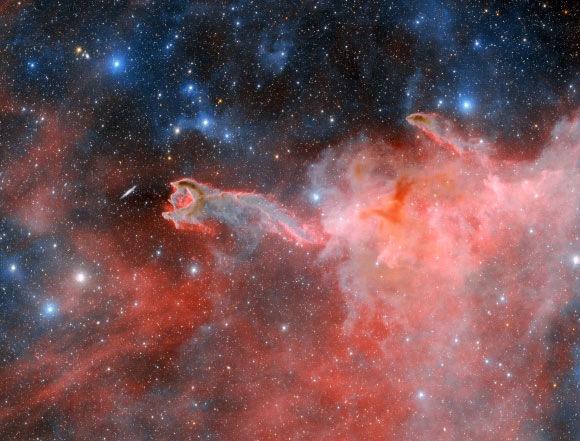Astronomers using the Dark Energy Camera (DECam) on NSF’s Víctor M. Blanco 4-m telescope at Cerro Tololo Inter-American Observatory, a Program of NSF’s NOIRLab, have imaged a dark, dusty cometary globule known as CG4.
This DECam image shows CG4, one of many cometary globules present within the Milky Way Galaxy. Image credit: CTIO / NOIRLab / DOE / NSF / AURA / T.A. Rector, University of Alaska Anchorage & NSF’s NOIRLab / D. de Martin & M. Zamani, NSF’s NOIRLab.
Cometary globules are faint, small clouds of gas and dust within our Milky Way Galaxy.
These objects were first recognized in 1976 on pictures taken with the UK Schmidt Telescope in Australia and their faintness makes them particularly challenging targets for color photography.
The cometary globule CG4, sometimes referred to as God’s Hand, is located in the constellation of Puppis, about 1,300 light-years away.
Its head is some 1.5 light-years in diameter, and its tail is about 8 light-years long.
The dusty cloud contains enough material to make several Sun-sized stars.
“Cometary globules are a subclass of the dark nebulae known as Bok globules — isolated clouds of dense cosmic gas and dust surrounded by hot, ionized material,” the NOIRLab astronomers said in a statement.
“When these clouds exhibit stripping of material that results in an extended tail, they are referred to as cometary globules because of their vague resemblance to a comet, though they have nothing in common.”
“The features that classify CG4 as a cometary globule are hard to miss in the new image.”
“Its dusty head, which has a diameter of 1.5 light-years, and its long, faint tail, which is about eight light-years long, make CG4 a comparatively small Bok globule, a general characteristic of cometary globules.”
“First recognized in 1976 from pictures taken with the UK Schmidt Telescope in Australia, cometary globules went undetected by astronomers for a long time because they are so faint,” they added.
“Their tails, shrouded in dark stellar dust, block most light from passing through.”
“But with its special hydrogen-alpha filter, DECam can pick up the faint red glow of ionized hydrogen present within CG4’s head and around its outer rim.”
“This light is produced when hydrogen becomes excited after being bombarded by radiation from nearby hot, massive stars.”
“The intense radiation generated by these neighboring massive stars, however, is gradually destroying the head of the globule and sweeping away the tiny particles that scatter the starlight.”
“Still, the dusty cloud of CG4 contains enough gas to feed the active formation of several new, Sun-sized stars.”
While astronomers have observed these structures throughout the Milky Way, the overwhelming majority of them, including CG4, are found within a huge patch of glowing gas called the Gum Nebula.
Believed to be the expanding remains of a supernova that took place about a million years ago, the Gum Nebula is currently known to contain at least 31 cometary globules in addition to CG4.
The mechanism by which these comet-like objects get their distinct shape is not entirely known, but astronomers have developed two main ideas about their origins.
The first idea is that they could have originally been spherical nebulae — like the well-known Ring Nebula — which were then disrupted by a nearby supernova explosion, possibly the original explosion that created the Gum Nebula.
The second idea is that cometary globules are shaped by a combination of stellar winds and radiation pressure from nearby hot, massive stars.
In fact, all of the cometary globules found within the Gum Nebula appear to have tails pointing away from the center of the nebula, which is where the Vela supernova remnant and the Vela pulsar are located.
The Vela pulsar is a rapidly spinning neutron star that was formed when a massive star collapsed, and it’s possible that its stellar winds and radiation pressure are shaping the nearby globules.
“Also in the new image it looks as if CG4 is about to devour the edge-on spiral galaxy ESO 257-19, which appears to be placed so defenselessly in front of it,” the researchers said.
“But in reality, this galaxy is more than a hundred million light-years beyond CG4 and only appears to be close because of a chance alignment.”
>>> Read full article>>>
Copyright for syndicated content belongs to the linked Source : Sci-News.com – https://www.sci.news/astronomy/decam-cometary-globule-gum-nebula-12913.html
